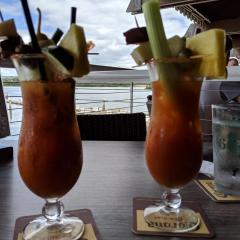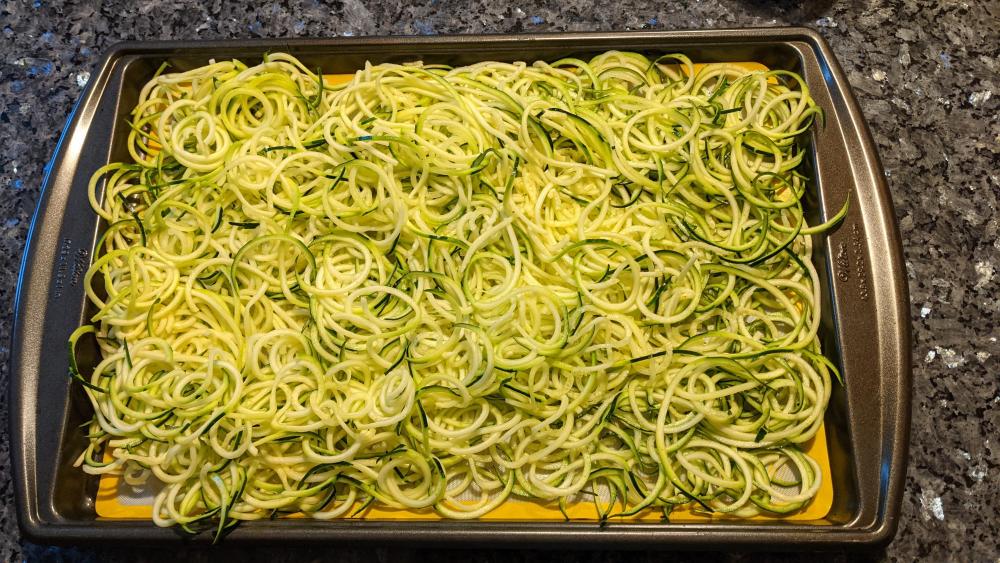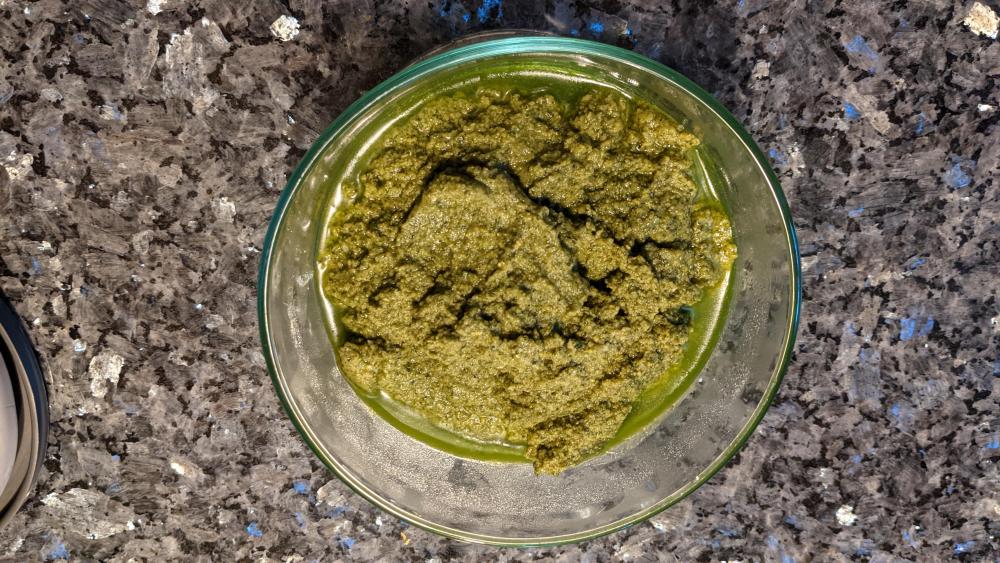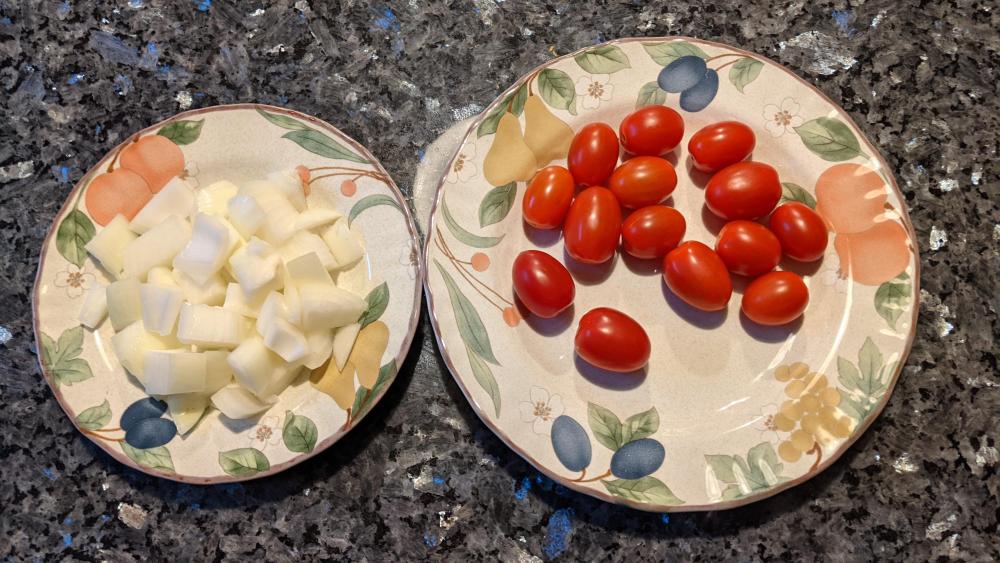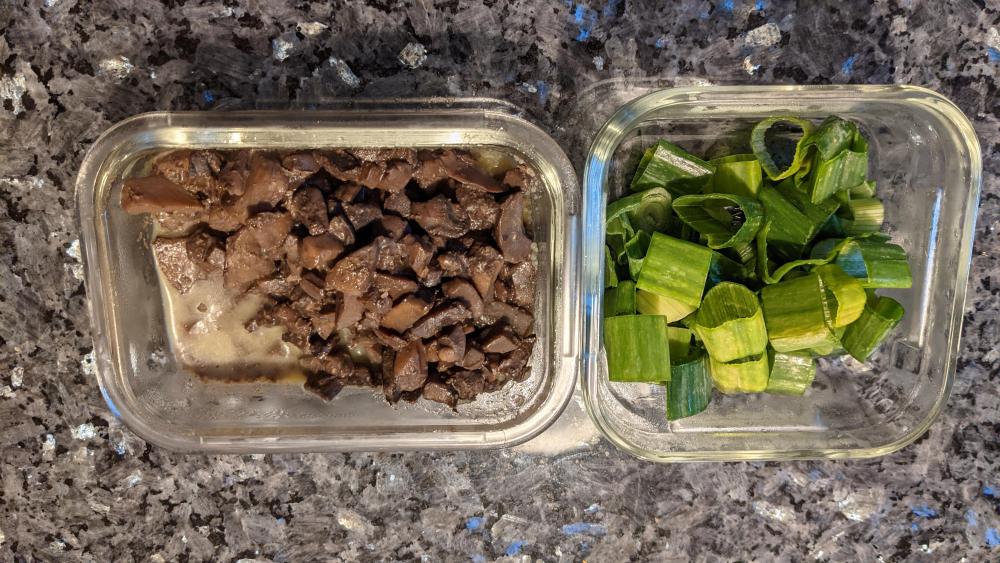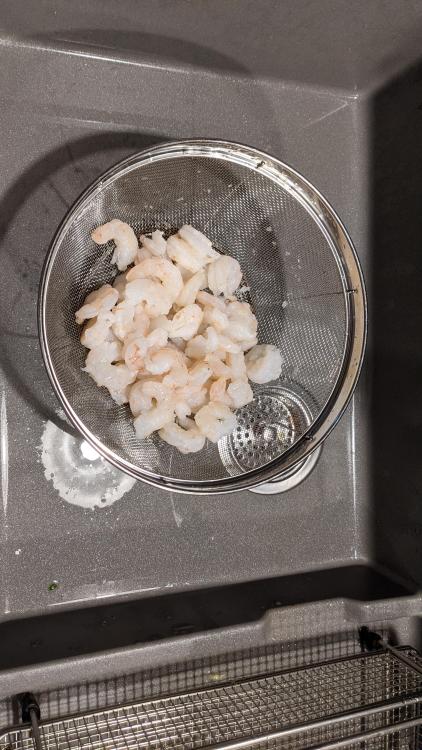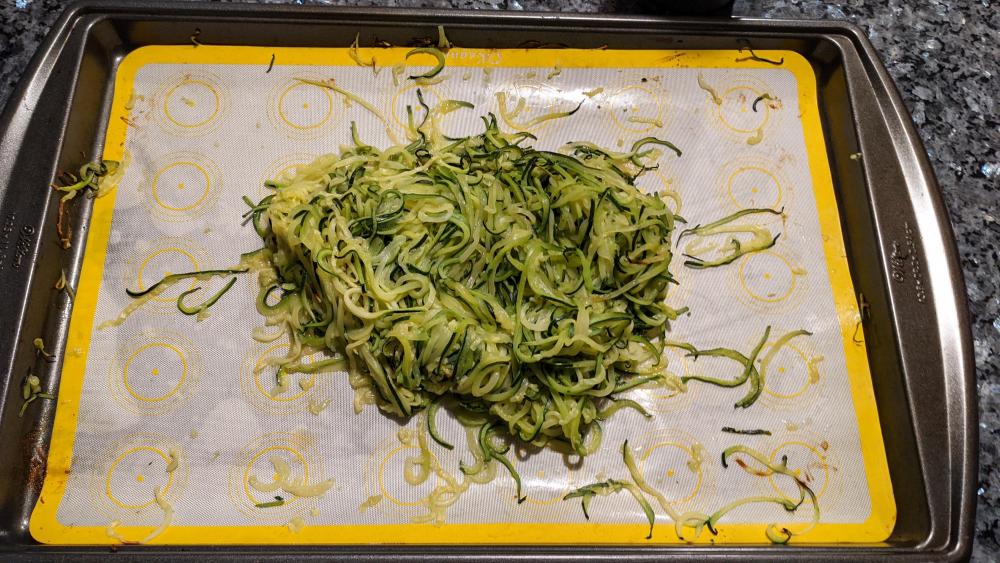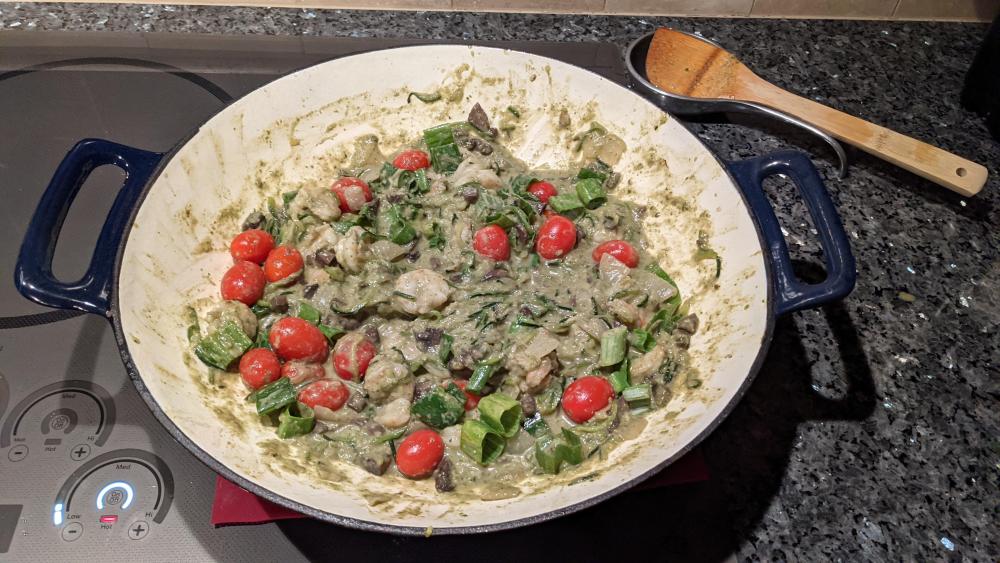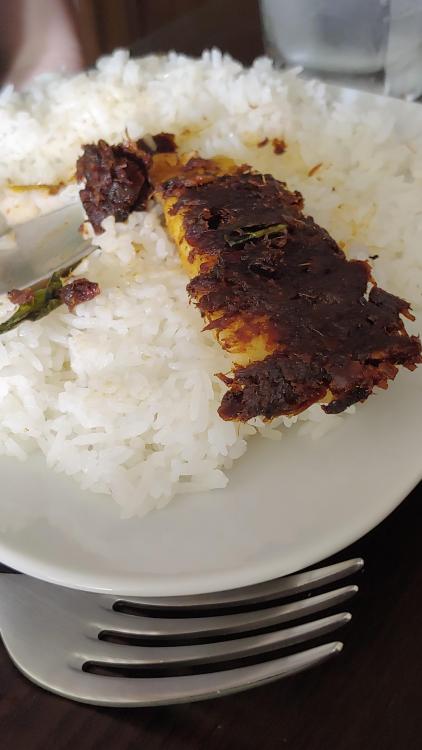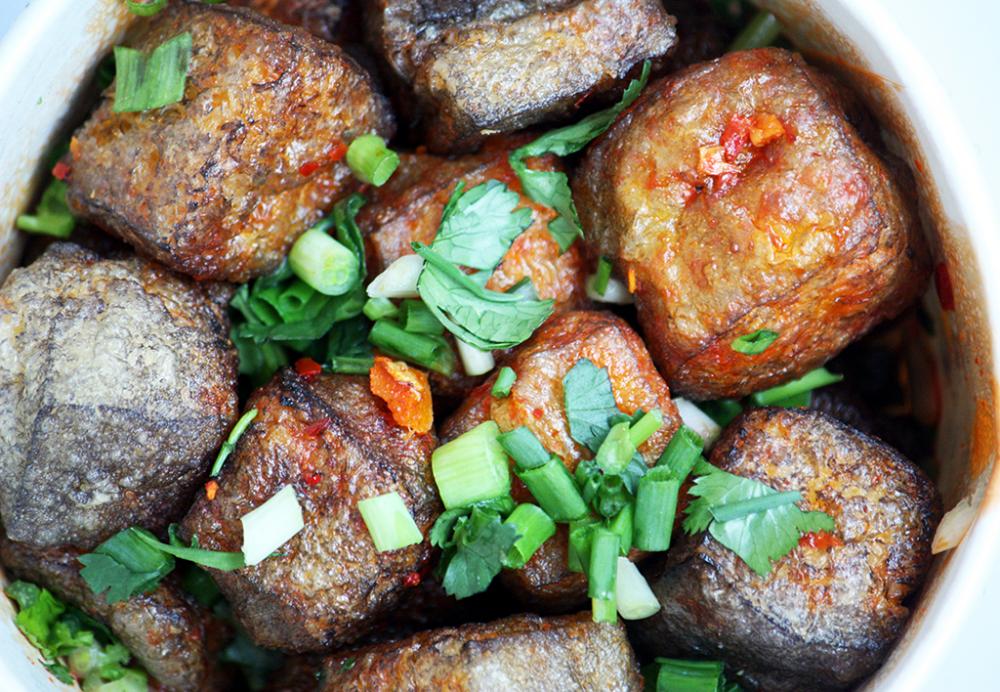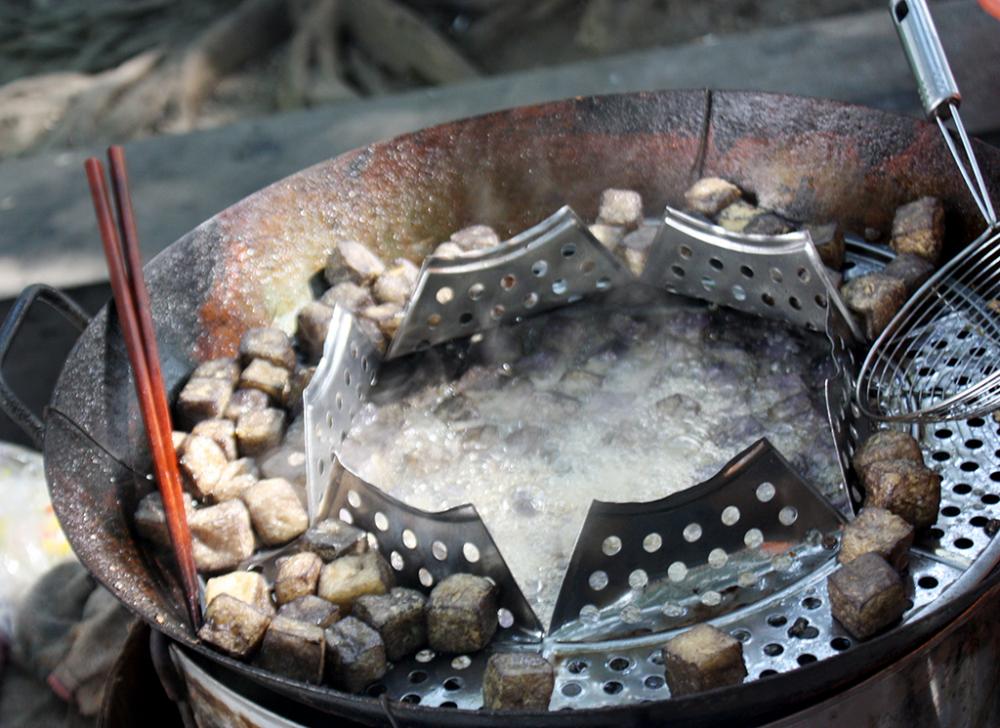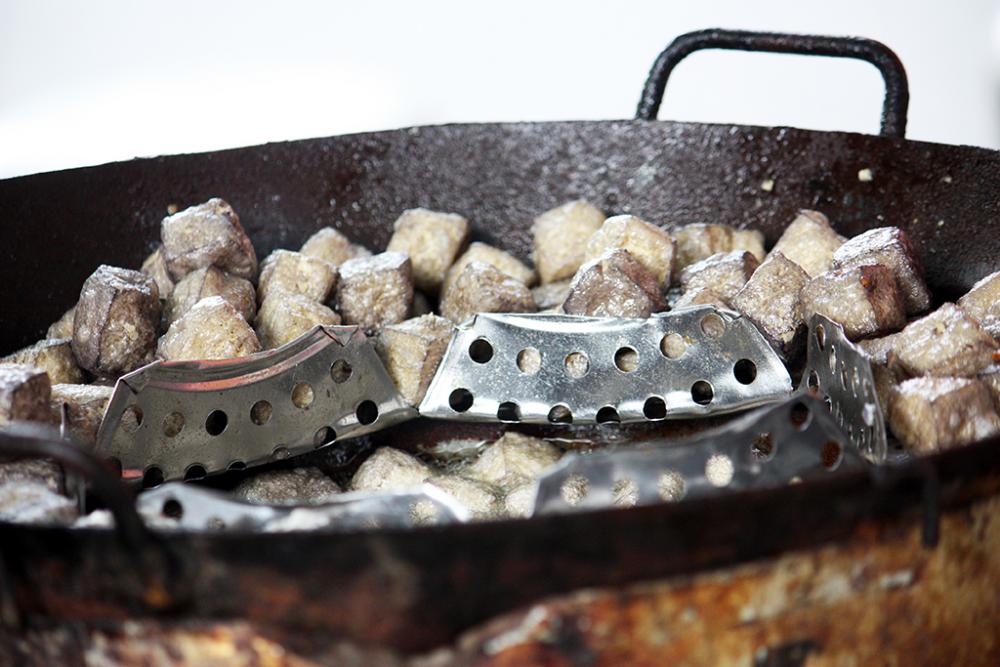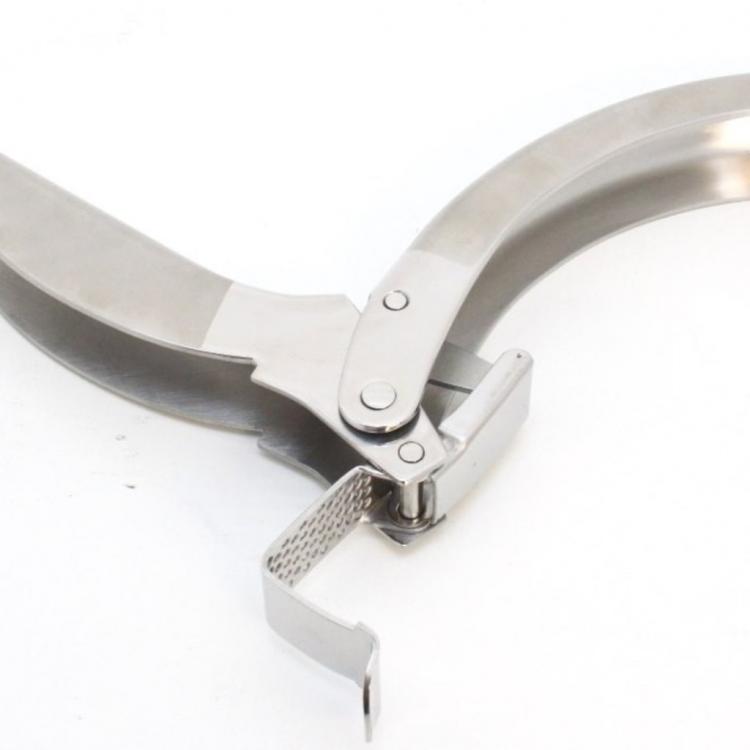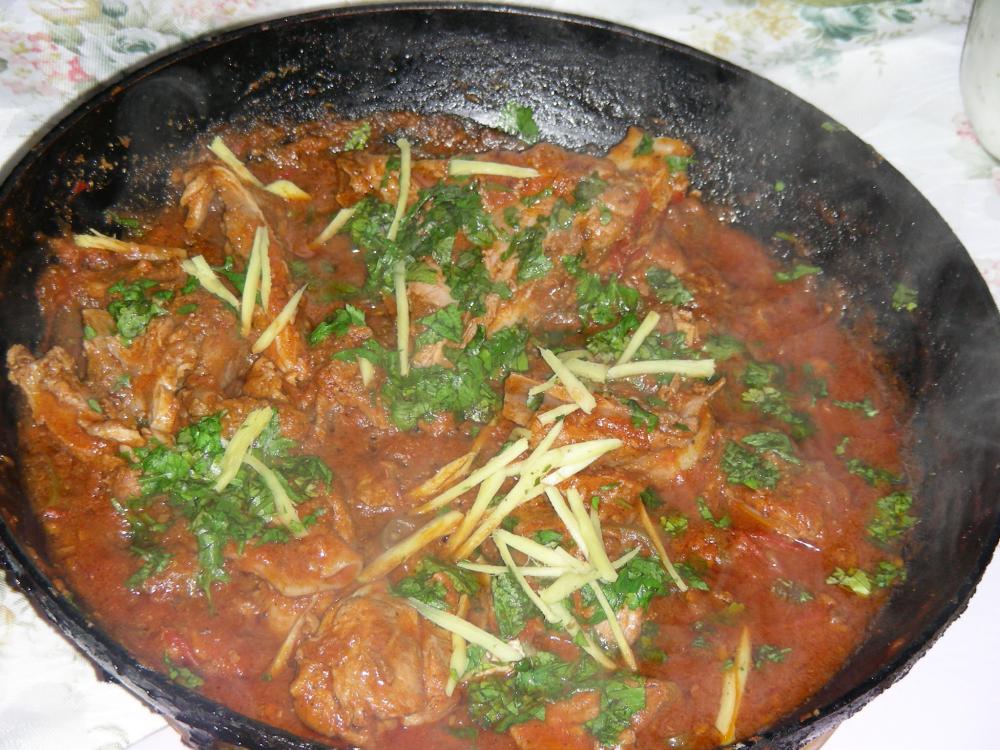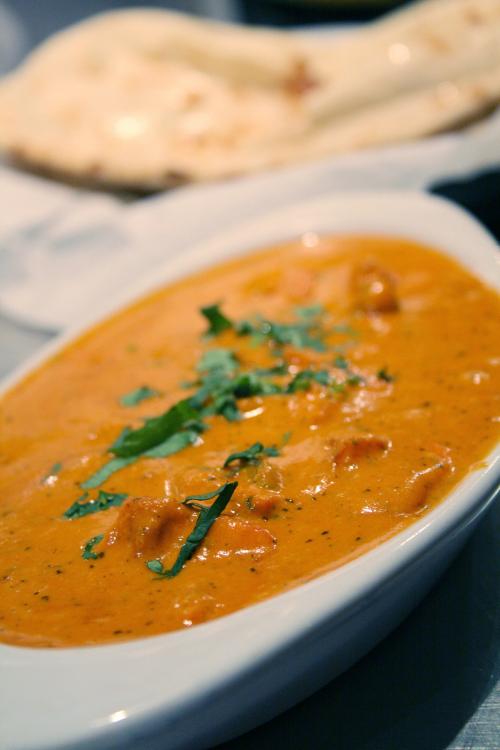Search the Community
Showing results for 'wok'.
-
I think that the perception of most of us in the western world is of the Chinese home cook crouched over a wok on a brazier fed with twigs and cow chips. With the advances that China has made I suppose that many home cooks have kitchens that resemble those in the West. Just as their style of cooking has to have changed, has the type of food that they are cooking changed? With the transport and availability of food from other regions, has it caused them to be less regional in their home cooking?
-
Shrimp pesto over zoodles. Zoodles before roasting: Zoodles after roasting (20 minutes at 350) in a convection oven, stirred twice. Shrimp: Fresh homemade pesto, our basil: Our onion, cherry tomatoes: Leftover bella mushrooms in red wine sauce and our onion tops: Wok heating up: Finished product:
-
From my perspective, nothing conveys quality & sturdiness like some good German names: Karl Otto Wilhelm Franz Siegfried and Friedrich (I would probably buy the Wilhelm 28 cm wok pan, and the Franz sauteuse …)
-
Tried some of the mahi mahi from my Wild Fork box. Quality was great - I don't think I'd be able to tell it from fresh. Defrosted naked in a big bowl of water for about half hour. Coated in rice flour then shallow fried in peanut oil in my wok, then spread with the belacan paste - oh so shrimpy with pounded rehydrated dried shrimp, shrimp paste ( belacan), dried chili, Thai chili, shallot, garlic,ginger, lemongrass and curry leaves from the garden.
-
16. 臭豆腐 (chòu dòu fu) – Stinky Tofu Another fermented bean curd preparation is 臭豆腐 (chòu dòu fu) or stinky tofu. This comes in various versions, but all have one thing in common – they stink! My favourite type is that which originated in Changsha, the capital of Hunan, the province to the north of Guangxi. Twenty-five years ago, I lived in a small Hunan city and behind the central market was a maze of streets. One of those streets was lined by hole-in-the-wall shops, all with low trestle tables and stools outside, selling stinky tofu and beer. I could always find the street in the maze – simply by following my nose. I could get there blindfolded. Changsha Stinky Tofu Traditionally, stinky tofu uses firm tofu which is then dried and then fermented for months in a brine also containing amaranth leaves, pork, dried shrimp and various vegetables. The Changsha style also incorporates winter bamboo shoot, and shiitake mushrooms, as well as koji, Aspergillus oryzae, a fungus used to promote fermentation During the fermentation process, the tofu develops a ‘hairy’ exterior, then begins to turn grey, at which time it is considered ready. Normally, the fermented tofu is then deep fried until black or dark brown and the outside is crisp. It is commonly served with a chili sauce. Hunan is chili central in China. In Hong Kong, it is eaten with hoisin sauce – preposterous idea, if you ask me! Here I can buy it on the streets from itinerant vendors with their portable stoves and cunningly designed woks in which the fried tofu can sit in these cages around the rim to drain, but also to keep warm. Stinky tofu being deep fried in Hunan Fried stinky tofu 'resting' in a cage at the rim of the wok. Once you get past the smell, the taste is creamy and mild, contrasting with the chilli sauce. Sort of like a funky cheese. Other, well-known varieties include Shaoxing stinky tofu. Shaoxing city in eastern China’s Zhejiang province is also, of course, famous for Shaoxing wine. Sichuan stinky tofu includes Sichuan peppercorns in the brine, while Tianjin in north China makes a milder, light-coloured version with less of the tell-tale smell. I've even seen stores selling 5-year-old Shaoxing stinky tofu brine on China's online shopping sites. 5-Year Old Shaoxing Stinky Tofu Brine Taiwan is also known for its love of stinky tofu, which they cook in many ways, besides deep frying. I’ve never been there, so can’t comment on that too much.
-
No, I got that. The fire brigade part was not meant to be taken seriously. I don’t suggest to fry the crab covered. Closing the cast iron with a lid is just a part of the „don‘t worry“ protocol in case things get too violent during the frying process. Otherwise you fry without, of course - there will be moisture evaporating. Whether this is more pronounced than for example frying a battered oyster or a zucchini is something I look forward to be answered by you 🤗 A cast iron might have an advantage due to the higher/„less sloped“ rim when it comes to splattering, but I am sure the large wok would work equally well.
-
Thanks. I'm actually not too worried about fire since I'll be doing it on induction, so there's no open flame for ignition. I thought of thinking of it like a frozen squid ring or croquette - but then I thought that the moisture content of a whole crab could be much higher. A battered piece of protein has most of its water in the batter (external to the meat and in direct contact with the hot oil), whereas a whole crab dusted in flour has most of the water frozen inside the shell. I was concerned about a pocket of water in the crab turning to steam and bursting, blowing hot oil all over the place. I'd worry even more about doing it covered as the steam leaving the oil would condense on the cover and drip back into the hot oil. I was thinking of doing the frying in my carbon steel wok (with a really powerful induction hob to bring back to temp quickly) - that way, there's lots of room for oil expansion.
-

A Year of Cooking, And I'm Using (blank) More Than Ever Before
EatingBen replied to a topic in Kitchen Consumer
Salt, butter, oil, gums, emulsifiers, wok. Except for the wok I’m now buying these things in bulk quantities to keep up. Oh also lemon and lime. -
When we bought our house, along with a lot of furniture I inherited a full set of Emeril cookwear. Sturdy, heavy as hell, with a thick copper pad sandwiched between the stainless base and the pan body, and entirely satisfactory. My husband prefers non-stick cookwear so he can scrub away to his heart's content, but I think he's remembering the bad old days of nonstick pans. In any case I'm not going to replace the Emerils, even though the high-sided saute pan (I guess you could call it a chicken fryer) is almost too heavy for me to pick up one-handed. Depends on which hand, of course. I also still have some of the old Revereware but I usually don't use them. The only one I use is a tall saucepan that works well for popcorn. And then there's cast iron. Three skillets, a wok (don't ask), a dutch oven, and a comal (griddle) that I use constantly. It lives on the stove.
-
I've been cooking on my Bluestar Platinum for about 5 years now, and about 90% of my cooking is in a wok. I have woks from 12" to 18" but I do 90% of my cooking on either a 13" or 14" wok. It won't be a problem to keep a 16" wok very hot, but you will have interference issues with other burners which you won't be able to use. I use the 18" mostly for steaming or boiling and only rarely for frying but again the limiting factor will interference with other burners - the Capitol wok burner is set off by itself to avoid this problem. I enjoy cooking on my Bluestar, which has been a game changer over my old Viking, but it's not perfect. The issue for me isn't so much power - its sufficient - as the way the wok fits in the burner, and to a lesser extent the dispersed shape of the flame. The burner basically engulfs the wok, which sits deep inside the burner, making it very, very difficult to move or toss the wok while you're cooking. If you look at a more traditional chinese kitchen setup, the wok sits much more shallowly atop a thinner rim, so that there is much less friction between the wok and the stove, allowing you to toss much more easily - almost impossible on the Bluestar. So the Bluestar can cook almost anything, but you won't be able to use traditional Chinese technique, and you'll have to toss the food by scooping it with a spatula, rather than using a ladle/spoon to help toss it with wok action. This isn't the end of the world, but if Bluestar understood how people cook, this could be easily fixed by changing the design of the grate so that it could cradle the wok rather than allow it to sit inside. Given Bluestar's lack of interest in improving the product, I've thought about trying to get a better grate forged myself, but haven't been able to put that together yet. A smaller problem with the burner, and one more difficult to fix, is that it would be better if all the heat were concentrated in the center of the wok, rather than dispersed in the star pattern. It's pretty clear that the ability to cook in a wok on the Bluestar is just a happy coincidence, and they don't seem very interested in trying to understand Chinese cooking technique - they could sell a lot more of these to Chinese-Americans if they understood how people cook, but their marketing is much more oriented towards Food TV type celebrities, and the only Chinese cooking videos I've ever seen on their site are by people who don't really seem to know how to cook Chinese food. Don't get me wrong, the Bluestar is still a very good choice for a Chinese cook, and will allow you to cook very good food in your home that the rest of the world can only eat in restaurants, but it could be much, much better with just a little effort if Bluestar cared to deal with these issues. The Bluestar griddle is another example of this tone-deafness, and clearly designed by people who never used the product to cook actual food. It's total crap, and has long been in storage and maybe tossed out at some point without me missing it. It just doesn't work, and increases the risk of grease fire markedly since it doesn't have a proper grease trap. Instead I use the largest De Buyer oval pan, which gives me an acceptable flat surface area, with less risk of fire, but still no grease trap so it needs to be drained manually (with spoon or by tipping) during cooking. Not really ideal.
-
@CentralMA - I've never been a big thrifter myself. Depends on the item. But you do you, of course. Just curious if I was missing something wok-specific. I think I'll just be buying something from Craft Wok. I might do both a 14" round and a 16" round. The Air Sled is a good idea... thanks for that. I might go that way to make the final push into place a bit easier. Or maybe I'll just recruit some muscle. My kitchen floors are ancient hardwood that's pretty beat already. What are a few more scratches except a little more character? My whole kitchen setup is going to be ridiculous when I'm done anyway... an old kitchen with beat-up midrange cabinetry and counters, appliances that don't match, and a premium monster stove in the middle of it. Franken-kitchen all the way, but I don't care. We'll gut it in 5-8 years, keep the stove, and trash everything else. We own a two-flat and we're already gutting the upstairs this summer at great expense, so now's just not the time to do the first floor kitchen. @gfweb - I agree that some cookware reconfiguration may be in order. There's a lot less need for cast iron's heat capacity if you can put 15-22K BTU's under a pan. Thinner carbon steel or stainless-lined copper would be more responsive. That will be interesting. I'm thinking a Matfer CS skillet or two would be good to have. @all - The griddle question is interesting. We don't own a proper big flat griddle at all right now. We rarely do big breakfasts or other dishes that want one, but once in a while it would be nice to have. When necessary, we use either our 12" Lodge CI skillet or a cheap 12" nonstick skillet for griddling and just batch food out. I've considered buying one of those inexpensive electric ones that folds up a bit for storage. Frankly, that just seems a whole lot easier than messing around with a double-burner stovetop griddle. But then I'd expect a *lot* more even heating from a BS too. Has anyone here tried it both ways? I like the idea of doing everything on the stovetop and saving a little on storage space, but I'm just not convinced it would really work much better. Plus it seems like grease draining would be a way bigger hassle/mess on the stovetop. @DerekW - The low-tech, DIY nature of BlueStar is absolutely the biggest draw for me along with the blazing heat. I want my appliances dumb and electronics-free. We're working on getting the space set up with a better range hood and ventilation right now, and I wish I could buy a decent-performing hood with an analog knob control for the fan and a simple flip-switch for the lights. Sadly, those don't seem to exist in the consumer space if you want decent CFM. It's all electronic buttons and LED displays if not capacitive touch sensors and auto-speed adjustment to boot. I fully expect the hood we bought will fail in 5-8 years and it will be some dumb electronic part around the buttons or display that would cost most of the price of the hood to replace. I'm hoping the BlueStar itself will last considerably longer than that.
-
K-R has made multiple designs over the years — the newer ones work like this, and they're amazing: I have lots of stuff from the Guardian article, of course: Ice cream maker — found an old Simac at a thrift store for $15 (!) and I use it occasionally to good effect. I hated my "freeze the bowl" one that I had prior. The compressor is really necessary for me to be bothered with it, but I'm not entirely sure I'd spend the money on a new one. Honey dipper — ok, I don't use it much, but it's also one of the smallest and cheapest things in my kitchen -- who cares? Popcorn machine — have one, but have mostly moved over to making my popcorn in a wok. So I guess this fails the test. If we made popcorn more often I'd get a whirly pop. Coffee grinder — I classify this as a medical necessity because my brain does not work without it. Bread maker — I unapologetically love mine. Great for sandwich bread on a weekday and great for dough when I want to do something fancier. Garlic press — someone mentioned on a Splendid Table episode recently that opposition to garlic presses is kind of a class thing in the UK, which I found fascinating. I use mine frequently but not exclusively. I have never gotten that side-of-the-chef's-knife garlic paste thing to work for me, though. As should be obvious from the image above, garlic getting stuck or wasted is not an issue with a well designed press; I have never seen one as useless looking as the one in the article. Electric juicer — I suspect they mean the grinding sort, which I don't have, but I do have a citrus juicer. I like it, but don't really use it all that often. I should use it more!
-
Stoves and Ovens: Wolf? Thermador? Bluestar? Viking?
CentralMA replied to a topic in Kitchen Consumer
Thrifting woks...it's the hunt, don't you know. I'm certainly not finding anything better in a product, but as I don't "need" them, I can wait for the fun to happen. Out in my area I can find good vintage carbon steel woks, most look like they've been used once or twice or not at all. Usually well under $5.00. I'm set, but I've been looking out for more for my youngest on their request. Same with other kitchen items. Recent finds have been a cast iron Weber branded skillet, designed to work with their "Gourmet BBQ System", I have the needed fixtures for my 22" kettle. Other recent Weber finds were a new in box vertical chicken roaster, and a new in box pizza stone accessory. Both vintage goods, and quite usable. Cast iron oyster grill pan? Got that too. Fun to use and looks great serving the table. And again, at less than 10% of what it would be retail. But, anyway. Talking about self installing... I went that route, but to an extreme. I picked up the stove at the dealer myself, got it into the back of a van, transported over state lines (sounds bad, huh? but saved a state tax...) and got it into my house with the help of a good friend. Saved me a bit over $600 (about 10%) off of other quotes in my area, that included delivery into the house, but not the actual installation. Remember that these stoves weight well over 300 lbs, getting them into a tight spot after hooking up the gas line is not easy. For our install I had a plumber in to extend our gas line to the kitchen area (we had electric stove previous). As part of the $500 charge he would come back for the final install, permit signing, etc. I rented an AirSled from a rental outfit some 30 miles away for a half day, about $30 or so. Scheduled the plumber for that time spot. With the AirSled and some extra shimming from scrap lumber for height the two of us were able to slide the stove in with just finger pressure on the front of the stove. It was like the 350 lbs was on ice. Once tested for operation, he left. I leveled it myself, again the Airsled in use. I also looked at getting the less expensive model, then eventually getting the hotter burner in by hook or by crook. But then the Gov't decided to pass out a bunch of $$$$, I decided to spend it on a true American made product (Something I don't usually look to do as a priority). That paid for half of it. And then incredibly enough, they gave me the other half this year? What's up with that? As part of the BlueStar purchase I agreed to put the electric oven in the basement, with 220v accessible. My wife was seriously concerned about the baking aspect. So far it's not been used. She also was somewhat against the purchase itself of the BlueStar. After the install and a couple of uses, she was going through the installation manual / instruction set and asked me why I didn't get the 36" with griddle? My oh my... And with the hot burners, get yourself some good thick carbon steel pans. Darto, de Buyer Mineral B, others. A pleasure to use. Indestructible. -
Don't have any problem here using a flat bottom, 14" carbon steel wok (from The wok Shop, iirc!) on 15K burners.
-
11C. Balti + More, not Baltimore Two dishes often said to be British innovations are among the most popular in Indian restaurants in Britain. Let's have a look. Balti, also known as balti gohst (Urdu: بالٹی گوشت, Hindi: बाल्टी गोश्त) is often said to have been invented by Bangladeshi chefs in what is now known as the Balti Triangle in Birmingham, England, sometime in the 1970s. Even the city government promotes the city by unequivocally sloganeering that “Birmingham is the original home of the Balti”. Given that balti has been known and eaten in northern India and Pakistan for many years longer, that seems unlikely. It is more likely to have arrived in Britain in the 1970s. Balti Gosht The word ‘balti' , found in several of the Indian subcontinent's languages seems to have originated in the Portuguese balde, meaning a bucket or pail. This was transferred to refer to type of deep cooking pot, resembling the Chinese wok. This was then transferred to a dish cooked in said pot, not an unlikely scenario when you consider that many dishes across the world’s cuisines are so named – casserole, tagine and paella leap to mind. Pat Chapman, founder of The Curry Club in the UK, who writes about Indian restaurant food, sees a link between balti and Baltistan, the Kashmiri state (administered by Pakistan), bordering China. Other writers dismiss this, pointing out the dish balti bears no resemblance to any food traditionally eaten there. Balti as served in Pakistan Whatever the origin of the dish, by the 1990s it had spread from a small area of Birmingham, across Britain and Ireland, then to places such as New Zealand and Australia. I’ve seen it on menus in Indian restaurants in Hong Kong. It is now even sold in British supermarkets in a do-it-yourself version. There is (or was) even a brand of Balti Wine, supposed to marry well with south Asian food, especially balti. It is/was made from Argentinian grapes, but developed in 2004 in Manchester, England by a Pakistani entrepreneur. It should not be confused with Bălți, the Moldovan wine region. Note: I have been unable to determine if this wine is still available. The company’s website is dead and the domain up for sale at ₤1,795 (~ $2,530 USD) So what is a balti, the dish? Basically, it is general type of curry, using customer chosen meats and vegetables, but instead of being slowly stewed like most Indian preparations, balti is quick fried using a stir-fry technique like that of Chinese cooking. It also tends to use vegetable oil as the frying medium rather than the ghee (clarified butter) used in most of the subcontinent. _____________________________________________________________________________________ And so I come to Britain’s National dish (according to Robin Cook (1946 – 2005), the late British government foreign secretary who praised the dish in a 2001 speech on Britain’s multi-ethnicity). Chicken Tikka Masala Chicken Tikka Masala According to the legends, in 1971, someone, said by some to have been a bus driver, somewhere in Britain, ordered the well-established dish, Chicken Tikka which originated in the Mughal Dynasty (c. 1526 to 1857). It is a dish of meat or paneer (a type of Indian soft cheese) marinated in yoghurt and spices then baked in a tandoor, a traditional clay oven (although today they may be made from steel.) The fabled bus driver found the dish too dry for his taste, so asked for it to be dressed in a curry sauce. A chef added some masala sauce and Chicken Tikka Masala was born! He spread the word more and more people requested the dish, so it was added to the menu increasing its popularity and other restaurants began to copy it. By the mid-1980s it was the nation’s favourite curry, if not quite a National Dish. It took another decade to cement that reputation. So much for legends. The first problem is that no one has ever definitively identified that restaurant where the genesis supposedly took place. Various claims have been made across the country from “near London” to Glasgow in Scotland. The modern-day pundits are very divided, with a few backing the bus driver theory to an Indian journalist suggesting a link to a dish from the Punjab region in the north of India bordering Pakistan. The most common, and in my opinion most likely, view is that it was invented by Bangladeshi chefs some time in the 1960s and lay dormant until awakened when discovered in the early 1970s. Many writers have noted its similarity to murgh makhani aka butter chicken, a dish of chicken in a spiced tomato, butter and cream sauce. This dish is known to have been invented in Delhi, India in the 1950s by the chef owner of the Moti Mahal restaurant. It is said the dish was invented accidentally when tandoor-cooked chicken was mixed with tomato gravy, rich in butter and cream. Sound familiar? Bizarrely, one writer also claims that Hannah Glasse’s 1747 recipe for curry which I referenced above is also similar to butter chicken, although how she copied a recipe created 200 years later goes unexplained. There is only a vague resemblance that I can see, in that they both use chicken and Glasse does fry her meat in butter, as did most cooks then. In the later version of her recipe, she also adds cream. She probably had no access to tomatoes, which were only then beginning to be eaten in Britain, despite having been introduced much earlier. The ‘fusion’ origins of the dish gain weight from the name, which itself is a fusion of different languages, tikka being from the Hindi or Punjabi टिका ṭikka, which in itself came from the Turkic word tikkü, meaning "piece" or "chunk", and masala from the Urdu ماسالا masala meaning “spice mix”. Whatever the origins, the dish has become Britain’s favourite curry and one of the nation’s top dishes.It is even said to be the second favourite 'foreign' dish for home cooking, but as the top favourite is Chinese stir-fry which isn't just one dish (actually more of a cooking technique), I'd call chicken tikka masala number one. From Britain, the dish has spread around the world, even being found today in India’s own trendy restaurants. Outrageous cultural appropriation, I say! 😂 Image Credits: 1. Balti Gosht - Image by ayes - licenced under CC BY 2.0 2. Balti Gosht in Pakistan - Image by Miansari66 - Public Domain 3. Chicken Tikka Masala - Image by Michael Hays -licenced under CC BY 2.0
-
@gfweb - I'm probably going to end up doing the actual install myself. The delivery guys are just going to drop it off in my kitchen, uncrate it, and level it. Any particular tips on installation from anyone are welcome. I'd gladly pay the $100 installation fee on the $4000 stove but that adds another layer of scheduling and another 2-3 week delay. I was lucky to find the RCS in stock right now at all with appliance availability being what it is. It's crazy finding anyone to do anything right now, or the parts for them to do it with. Plus I like doing things myself when I can. I totally agree that 15K is damn hot already. I stir-fry now on a 15K Iwatani butane burner and I'm not at all unhappy with it. The basic Bluestar does that already with a far better burner pattern and stability for round woks. But... I *can* do a 22K, right? For less than $200 and a bit of tinkering? Seems pretty attractive, even if hardly necessary. As I understand it, there's absolutely no difference in the actual stove between the RCS and RNB beyond the burner parts themselves. Yeah... warranties, insurance, etc. I get it. I do. Like I said, not sold yet. Gonna get it in and play around with it and see what I think. @CentralMA - I'm curious about what exactly you were looking for in thrifting woks like that. Is there something you were looking for that you couldn't find elsewhere? Even a high-end 16" hand-hammered carbon steel wok isn't all that expensive. As for the gas oven... yeah, I thought about that a lot. I do some reasonably serious cake and pastry work myself. But all the absolute worst horror stories I read about Viking/Wolf gear revolved around dual-fuel ranges with dodgy oven elements that hit owners for $1K repair bills over and over and over. I can live with a gas convection oven in exchange for a better shot at reliability. I could get cakes I was proud of out of my old crappy Maytag... I'm sure I can do at least that well with a Bluestar gas convection unit. If I want to get really hardcore about it, I could get a small commercial convection oven and run it in the mud room off the kitchen. Probably that would require a 220V line, but that's not so expensive to install if I really want it. Better - IMO - than worrying about the reliability of our main range. YMMV. But I very much doubt I'll ever go that far.
-
Stoves and Ovens: Wolf? Thermador? Bluestar? Viking?
CentralMA replied to a topic in Kitchen Consumer
OK. As the original poster I'll add in here. I love my BlueStar. I did go with the big burners, and Im glad I did. I've sourced two woks, thrift store finds (months of searching, I'm picky), sizes vary by about 2 to 3 inches. Maybe 4. My wife works with some lovely people that have been instructing her on the finesse of Vietnamese eggrolls. With the woks and the BlueStar the results have been very nice. My wife, the baker, has adjusted to a gas oven. Great results. My recently acquired heavy Darto pan has become the implement of choice. It just gets better and better. I should have bought this years ago. -
Definitely adjust the simmer burner. There are you tubes...very easy. Or ask the installer to do it I just have the 15 K burners which are plenty hot for any cooking I do. Certainly hotter than what's in a Chinese home range where lots of woks are used.
-
As others have noted, this has been an informative thread - thanks all! I just purchased a new 30" open-burner RCS - pedestrian by Bluestar's standards, but quite the dream of mine. I'm looking forward to getting it installed in 2 weeks or so after we get some other work done for a backsplash and hood. It will be perversely amusing seeing a kick-ass range like that in our shabby old kitchen... function over form, baby! Maybe we'll rehab the kitchen once we put the kids through college and with luck the Bluestar will still be kicking by then. Any info or tips on the current Bluestar RCS or parts are appreciated. Sounds like I'll want to give some attention to adjusting the simmer burner at least. I'm interested in the "DIY 22K Burner" option that others have mentioned. Seems like the 18K/22K burners are still available online without a serial number and the orifice is a standard part, unless something has changed recently. I could easily live with "just" the 15K burners but having a single 22K sounds awfully enticing for stir-fry work. If anyone has, like... burned their house down - or racked up a huge repair bill - that would be nice to know. I'm not sold on it either way yet. We'll have a relatively modest 450 CFM hood running at 28" above the stove, but I can't see us running more than a single burner at full blast. It's rare I have more than two pots on the stove in the first place, especially if I'm stir-frying. I'm also looking ahead to replacing my old 14" flat-bottom wok with a mix of excitement and sorrow. My girlfriend (now wife of 20+ years) and I mail-ordered that wok from The Wok Shop back in college. Ah... the days of putting a check in an envelope. The wok is the oldest pan in our kitchen. But I've got to get a round-bottom wok to use those fancy new burners, right? Do Bluestar wokkers go with a 14" or 16"? Or even something bigger? Seems like the burners should handle a 16" (especially at 22K), which would be convenient when stir-frying for bigger groups though it probably doesn't leave much space on other burners. I could maybe do both a 14" and a 16" round. Storage space isn't that tight here. Can't wait to cook on this thing.
-
-
No Searzall for you? Serious Eats talks about torches and wok hei here...seems as if they are in disagreement with some posters.
-
Wok hei is not my main goal for the torch. And I agree that wok hei is not needed in most dishes, as well as that the flavor a torch will bring is not exactly wok hei. I do hope that it will give some grilled flavor, which I think complements many dishes (even if it's not necessary). For example, a few things I might use it on: - Vegetables for salsa, or other salads/sauces where charred flavor is wanted. - Neapolitan pizza, when I feel like having the more traditional texture-flavor. I imagine that I can shorten the baking time to just until the dough is cooked through, then proceed to torch it so that it can some charred crisp spots without drying or over-cooking the cheese. - Browning/melting things that don't fit a pan without turning on the broiler (casseroles, things topped with cheeses etc). - And also charring ingredients in order to add flavor to dishes where it works well - fried rice, some noodles dishes and also non-Asian dishes like (vegetarian) burgers and grilled corn - Any other ideas?
-
I have a torch I use when cooking, but there is no way it can give wok hei! That only comes from a wok, well seasoned from contiuous daily use over a long period of time. But I've said many times before,wok hei is a concept only Americans seem to obsess about. Most Chinese cooks aren't interested.
-
I agree with @ElsieD and the others. I recently moved into a kitchen with no gas service and plan to have 2 countertop induction hobs. I have teh first one (the relatively inexpensive one) now and will be bringing in the other, expensive one, soon. Even the cheap one is a pleasure to use - the near instant heating for pans, super fast water boiling, plus I can stand near it and not get hot like I would have with gas. For water boiling type stuff, I've been using an old Le Creuset enameled cast iron dutch oven and I'm amazed that I can have water boiling in it, and still grab the handles without a pot holder. I also have a carbon steel wok which is great to use with it - even though I don't have super fine power control on the cheap unit. And if I want to quickly blanch something - I can put maybe 6-8 cups of water in the wok and it will be boiling in about a minute. For the thin carbon steel, when the cheap one cycles on and off, I can definitely see when this happens if I have a small amount of liquid simmering in it - and I have also burned some things once or twice due to a hot spot that I wasn't constantly stirring - like I would be with a stir fry. Eventually I'm going to get a stainless pan with aluminum or something in the core - that should help distribute the hot spots more evenly than the carbon steel.
-
I do have a beautiful, well seasoned, just short of 12 inch cast iron wok -- or since it is Japanese, what they call Chinese cooking vessel. But since I am afraid to ruin it, what I usually grab is my banged up 3-ply Thai stir fry pan.



